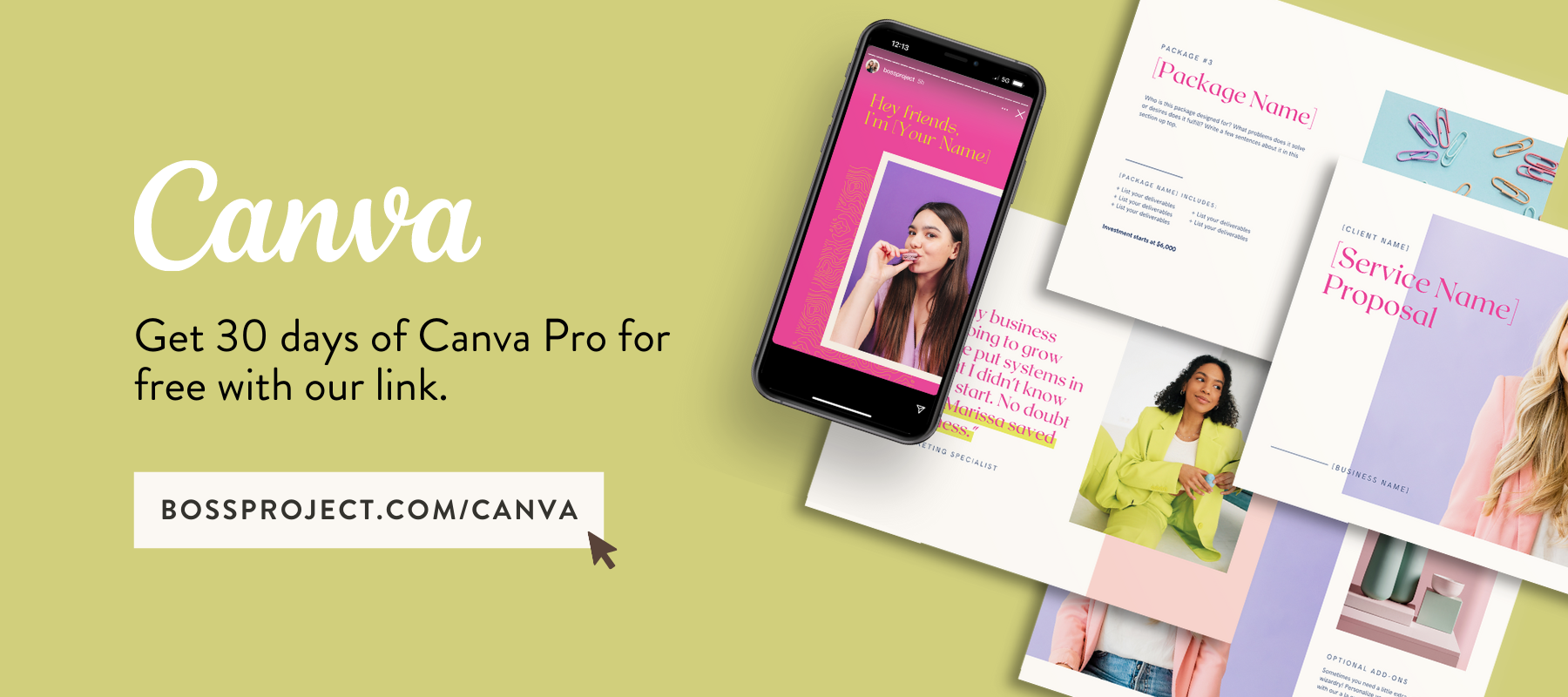5 Things to do Before You Pitch (prepping your biz for publicity)
You've watched your friends, colleagues and competitors land guest blog posts, podcast and television interviews and features in your favorite magazines. (You know, places like The Huffington Post, Being Boss and, ahem, this here blog.) They’re getting featured and getting the chance to grow their audience, boost their revenue and earn the kind of credibility you crave.
You want to have that experience – and that success – too. So you jump straight to working on some pitches of your own and end up missing a crucial step in the process of getting featured. (Don’t worry – almost everyone does.)
You miss the step where you get your business ready to get featured before you hit send on a pitch, and that’s what I’m going to teach you how to do today using five simple steps.
But first, if you’re wondering why you need to spend a little time and energy getting your business ready to get featured, here are a few reasons. These steps will help you:
Look like a total boss when the people you’re pitching to check out your work (increasing your chances of getting a yes).
Boost your confidence so you can show up like the talented professional you really are.
Better leverage that first feature (and every one that comes after it) by helping you learn how to capitalize on that moment when everyone’s eyes are on you.
Ready? Let’s break down those 5 steps so you can see how easy they are and learn exactly what you need to do to get ready to get featured.
Step 1: Nail Your Elevator Pitch
If you’ve owned your own business for more than a hot minute, you know how hard it can be to answer that basic question, “What do you do?” without fumbling your way through a reply. And, whether you’re at a networking event or a neighborhood barbecue, you also know that it can feel pretty damn awkward to try and explain your work to people who aren’t in your industry (or worse, people who haven’t even heard of your industry).
An elevator pitch will solve that problem for you – but not just any old elevator pitch. What you need is a value-centered elevator pitch that puts the focus on who you serve and how you help them so you can talk about what you do with ease.
Here’s how you can create your value-centered pitch in three simple steps.
Describe the people you help (your target audience, ideal client, customer avatar, etc.).
Describe how you help those people.
Describe the results people get when they work with you or buy a product or service from you.
Now combine your answers from part one, two and three to create your elevator pitch. Here’s how it all comes together in a fill-in-the-blank formula:
I’m (NAME). I help (DESCRIBE WHO YOU SERVE) by (DESCRIBE HOW YOU HELP) so they (DESCRIBE YOUR RESULT).
Here’s my value-centered elevator pitch as an example. Once you have yours, you can use it everywhere from email pitches to get-to-know-you conversations with podcast hosts.
I’m Ashley. I help creatives and entrepreneurs stop over-complicating things and learn to simplify their business (not to mention their to-do lists) so they can make more money and experience more freedom in their life.
Step 2: Elevate Your Press Bio
When you get a yes on a pitch, one of the first things you’ll be asked to send over is your bio. Please don’t treat this request as an afterthought, because your bio is just as important as the feature itself. It is, after all, the piece that tells people who you are, what you do and how they can connect with you more.
If your bio doesn’t exist or it bores people to death, you’ll miss out on that valuable opportunity. That’s why I recommend creating an engaging bio around four elements, which are:
Your elevator pitch (to quickly communicate who you work with and how you help them)
A few relevant professional accomplishments (to add credibility)
A few personal details (to show that you’re human)
A call to action (to invite the audience to continue engaging with you)
Here’s how it all comes together in a fill-in-the-blank formula:
(YOUR NAME) helps (DESCRIBE YOUR PEOPLE) by (DESCRIBE HOW YOU HELP) so they (DESCRIBE YOUR RESULT). Through her work, (NAME) has (HIGHLIGHT RELEVANT ACCOMPLISHMENTS). When (NAME) is not working, she (SHARE PERSONAL DETAILS). To receive/sign up for/join (NAME’s DESCRIBE YOUR CALL TO ACTION), click here.
You can check out my bio at the end of this piece to see how it all comes together.
Step 3: Prep Your Press Page
Here’s a little secret you may not know about the media, brands and other professionals you’re pitching to: though they’re often slow to respond to your pitches, they almost always expect a tight turnaround time from you.
So the last thing you want to do when you get a yes on a pitch is waste time scrambling to find your bio or that perfect headshot on your hard drive. You want to reserve your time and energy to prepare the content you’ve promised to deliver, not find the stuff you need to submit with it.
The solution is to create a press page, which keeps all those deliverables in one central place. When the time comes to share them, you’ll just send along a single link that creates a ton of ease for you and makes you look like a total professional too.
Here’s what your press page should include at a minimum:
A selection of headshots
Your bio
A downloadable logo
You can post these elements in a secret (unlinked) page on your website that’s only accessible if you share the link. To view my press page, just click here. (www.ashleymgartland.com/press)
Step 4: Strengthen Your Social Media Platforms
There’s a good chance the people you pitch to will check you out on social media – and if they see an out-of-date profile or off-brand posts, it could raise a red flag about you or your work.
You don’t want to open the door for people to question your credibility. Instead, you can set up your social media to work in your favor by making sure all your profiles meet the five Cs, which are:
They’re current.
They’re consistent.
They’re credible.
They’re set up to convert.
They’re characteristic of your brand.
Take the time to review your social media profiles through the lens of these criteria – if you find that they meet them, they’re ready for you to start pitching. If not, you probably just need to make a few tweaks to get them there, like deleting off-brand posts (so that everything is characteristic of your brand) or adding an opt-in or sign-up button (so you know the profiles are ready to convert new leads).
Step 5: Ready Your Website
It almost goes without saying that the people you pitch will use your website to confirm that you’re legit and learn more about you. Your website is also the first place potential customers go when they learn about you through a feature, which means it pays to make sure it’s ready to convert any traffic you’ll get.
Here’s the good news: to accomplish both those goals, your website just needs to do two things:
It needs to clearly communicate what you do and how you help people. The easiest way to communicate these details is to include your elevator pitch on your homepage. But you can also weave this information into your about page, share it in client testimonials or case studies or on your services page.
It provides an opportunity for people to connect with you in another way. A simple contact page will accomplish this goal just fine, but you can also include an opt-in or call to action on your site that entices people to join your email list or a Facebook group. Additionally, you can include social icons on your site so visitors can engage with you long after they leave.
These steps might feel daunting at first, but I can assure you that they’re totally doable. (Simplicity is my thing, so you can trust me when I say I won’t over-complicate this process for you.) In fact, if you tackle one each day for the duration of a work-week, you’ll be done in time for happy hour on Friday.
ABOUT THE AUTHOR
Ashley Gartland helps creatives and entrepreneurs stop over-complicating things and learn to simplify their business (not to mention their to-do lists) so they can make more money and experience more freedom in their life. Ashley has been playing the entrepreneur game since she was 22, when she got her start as a food writer. After a long run doing everything from testing cocktail recipes to working as an editor at a digital media startup, Ashley launched her coaching practice to show other women that building your business doesn't have to be so hard.
Ashley's work has been featured in O, The Oprah Magazine, The Huffington Post and Being Boss. She lives for rainy days, has a soft spot for prime-time "soap operas" and prefers kombucha over coffee to fuel her day. To join Ashley's free Facebook community for creatives and entrepreneurs, visit The Simplified Entrepreneur.



